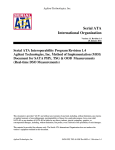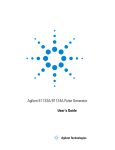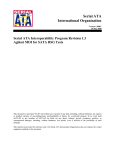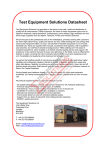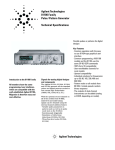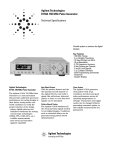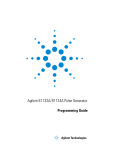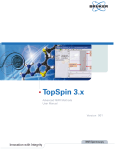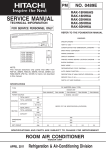Download Agilent Technologies 81133A Specifications
Transcript
Getting Started with the Agilent Pulse Generator 81133A/81134A You only need a few minutes to get started with the Agilent 81133A and 81134A Pulse Generator. i o n, rmat , info ing Guide ing m mm gram gra Pro . pro the t CD te nd oduc a pr he Fo r m please ore ex refe amp r to l t h e es a n del Use d re iv e r G m red u o on ide t This Getting Started Brochure helps you to quickly understand the operating principles and set up your first signals. If you need more detailed information on the Agilent 81133A and 81134A Pulse Generator, check out the Online Help. Notice Safety Summary Copyright General Safety Precautions The following general safety precautions must be observed during all phases of operation of this instrument. Failure to comply with these precautions or with specific warnings elsewhere in this manual violates safety standards of design, manufacture, and intended use of the instrument. © Agilent Technologies, Inc. 2002. Revision Revision 1.0, August 2002 Printed in Germany Agilent Technologies, Deutschland GmbH Herrenberger Str. 130 71034 Boeblingen, Germany Agilent Technologies Inc. assumes no liability for the customer's failure to comply with these requirements. Before operation, review the instrument and manual for safety markings and instructions. You must follow these to ensure safe operation and to maintain the instrument in safe condition. Technology Licenses General The hardware and/or software described in this document are furnished under a license and may be used or copied only in accordance with the terms of such license. This product is a Safety Class 1 instrument (provided with a protective earth terminal). The protective features of this product may be impaired if it is used in a manner not specified in the operation instructions. All Light Emitting Diodes (LEDs) used in this product are Class 1 LEDs as per IEC 60825-1. Environmental Conditions Warranty This instrument is intended for indoor use in an installation category II, pollution degree 2 environment. It is designed to operate at a maximum relative humidity of 95% and at altitudes of up to 2000 meters. The material contained in this document is provided “as is,” and is subject to being changed, without notice, in future editions. Further, to the maximum extent permitted by applicable law, Agilent disclaims all warranties, either express or implied, with regard to this manual and any information contained herein, including but not limited to the implied warranties of merchantability and fitness for a particular purpose. Agilent shall not be liable for errors or for incidental or consequential damages in connection with the furnishing, use or performance of this document or of any information contained herein. Should Agilent and the user have a separate written agreement with warranty terms covering the material in this document that conflict with these terms, the warranty terms in the separate agreement shall control. Refer to the specifications tables for the ac mains voltage requirements and ambient operating temperature range. Before Applying Power Verify that all safety precautions are taken. The power cable inlet of the instrument serves as a device to disconnect from the mains in case of hazard. The instrument must be positioned so that the operator can easily access the power cable inlet. When the instrument is rackmounted the rack must be provided with an easily accessible mains switch. Restricted Rights Legend If software is for use in the performance of a U.S. Government prime contract or subcontract, Software is delivered and licensed as “Commercial computer software” as defined in DFAR 252.227-7014 (June 1995), or as a “commercial item” as defined in FAR 2.101(a) or as “Restricted computer software” as defined in FAR 52.227-19 (June 1987) or any equivalent agency regulation or contract clause. Use, duplication or disclosure of Software is subject to Agilent Technologies’ standard commercial license terms, and non-DOD Departments and Agencies of the U.S. Government will receive no greater than Restricted Rights as defined in FAR 52.227-19(c)(1-2) (June 1987). U.S. Government users will receive no greater than Limited Rights as defined in FAR 52.227-14 (June 1987) or DFAR 252.227-7015 (b)(2) (November 1995), as applicable in any technical data. Services and Support Any adjustment, maintenance, or repair of this product must be performed by qualified personnel. Contact your customer engineer through your local Agilent Technologies Service Center. You can find a list of local service representatives on the Web at: http://www.agilent.com/Service/English/index.html 2 Ground the Instrument To minimize shock hazard, the instrument chassis and cover must be connected to an electrical protective earth ground. The instrument must be connected to the ac power mains through a grounded power cable, with the ground wire firmly connected to an electrical ground (safety ground) at the power outlet. Any interruption of the protective (grounding) conductor or disconnection of the protective earth terminal will cause a potential shock hazard that could result in personal injury. Do Not Operate in an Explosive Atmosphere Do not operate the instrument in the presence of flammable gases or fumes. Do Not Remove the Instrument Cover Operating personnel must not remove instrument covers. Component replacement and internal adjustments must be made only by qualified personnel. Instruments that appear damaged or defective should be made inoperative and secured against unintended operation until they can be repaired by qualified service personnel. Installing the Agilent 81133A and 81134A Check if the Agilent 81133A or 81134A shipping container contains the following standard deliverables: The Agilent Pulse Generator 81133A or 81134A Agilent Pulse Genarat or This Getting Started Brochure power cable The Product CDs USB cable If the contents are incomplete, if there is mechanical damage, or if the instrument does not work within its specifications, notify the nearest Agilent office. The Agilent office will arrange for repair or replacement without awaiting settlement. Once you have plugged in the instrument, you can start using it. Make sure you keep the ventilation holes free wherever you install the instrument. The USB interface will be supported starting spring 2003. Please visit our Web page for a free update of the firmware. Please refer to the User Guide delivered on the Product CD if you need more information about working with the instrument. 3 Getting Started with the Agilent 81133A and 81134A Now that you have unpacked the instrument and plugged it in, let´s take a look at the main elements of the front panel. Softkeys Numeric Keys Global inputs and outputs Navigation knob Channel-specific inputs and outputs Tab Keys to navigate between the pages Switch on the instrument. You can immediately start playing with the settings. Start by pressing the tab keys. You see that only the lower part of the panel page changes. You can switch between five panel pages, which allow you to set parameters for different instrument settings. The parameters at the upper part of the panel page are valid for the whole instrument. Navigate through the pages with the Tab Keys Main Page Channel Page 4 Config Page Data Page Aux Page Changing Parameters The navigation knob makes it easy to move through and set the parameters. Rotate the navigation knob to move from one parameter to the next. Let’s select a parameter from a selection list. Press the navigation knob to open the selection list (like clicking with the mouse). Rotate the navigation knob to scroll through the list. Select an item by pressing the navigation knob. You have three options for using the navigation knob. rotate press press and rotate 5 Changing Parameters Now let´s change a number field Press the navigation knob once to focus at the number field. When you rotate the navigation knob the value changes. You can do this in run time. It let’s you immediately see the changes on a scope. Turn the navigation knob to set the number Or, to change one digit Press the navigation knob once when you are done. Press and rotate the navigation knob to select the digit. You can also press the arrows next to the navigation knob. Release the navigation knob. Now when you rotate it, the number changes. Press the navigation knob once when you are done. You can also: 6 Use the arrows next the navigation knob to select a digit. Enter a value with the key pad. Setting Up a Data Pattern Imagine, you have designed a new digital circuit with ECL logic and 3.3 GHz clock, and you want to check its correct behavior. To test it, you decide to simulate a 32-bit pattern signal with NRZ data output format: 11110011100110010010100100000000 Protect the DUT Whenever you change a parameter, the generated signal immediately changes. To protect your DUT, make sure you disconnect the channel outputs first. Do this by pressing the softkey next the following function: The open contactor shows you that your DUT is now disconnected Now let’s set the instrument parameters These define the signal that will be generated. 4 Select the Unit 3 Enter the Frequency value using the keypad 1 2 First, disconnect the outputs to protect the DUT Choose the Pulse/Pattern Mode for the Signal 7 Setting Up a Data Pattern You can now set the channel mode, timing and level parameters for the channel 3 Indicates that the Parameters are set for Channel 1 4 Select the ECL level format The LEDs show the status of the outputs gray = disabled, green = enabled, crossed out = all outputs disconnected 5 Select Pulse Type NRZ Enable the Channel 1 normal Output by pressing the respective softkey 2 - Select Pulse Mode Data You can switch between the two channels by pressing this softkey 1 Switch to the Channel Page Now let’s set the data 3 Enter a data pattern length of 32 bits 4 2 Enter your data pattern Switch to the Numeric Edit Mode 1 Switch to the Data Page 8 Setting Up a Data Pattern Reconnect the DUT When you are done, you can reconnect the DUT by clicking the following softkey: If you attach a scope (as DUT), you can immediately see the signal You can use the generator’s trigger output to trigger the scope. The LEDs tell you which outputs are enabled 2 Enable the Trigger Output ... ... or press the Trigger Out softkey 1 Switch to Aux Page Now you can view the data pattern and the trigger output signal on your oscilloscope 9 What Else You Can Do The Agilent 81133A and 81134A Pulse/Pattern Generators are high-end, easy-to-use tools for generating pulses, patterns and data at speeds up to 3.35 MHz. They are ideal instruments for testing logic devices (for example, ECL, LVPECL, LVDS) and other digital devices with clock rates from 15 MHz to 3.35 GHz. You can use the Pulse/Pattern Generators for applications where timing and performance are critical and full control over signal jitter is required. The instruments are ideal data and pattern sources for eye diagram measurements. Your advantages are Fast rise times, low jitter and full parameter flexibility When timing is critical, the 81133/34A’s fast rise times, the low jitter and full parameter flexibility make it an ideal pulse, clock and data source. PRBS from 25-1 to 231-1 You can evaluate the performance of a device in eye diagram measurements with PRBS from 25-1 to 231-1. Full signal manipulation You can add jitter to clock or data signals with the Delay Control Input and deform the eye with the Variable Crossover Point. Predefined Levels You can use the predefined levels to easily set up channels for commonly used logic families. These are: ECL, LVPECL, LVDS. Data can be 8 kB of pattern memory You can create large data patterns with 8 kB of pattern memory. Agilent Email Updates http://www.agilent.com/find/emailupdates Get Free Email Updates Keep up to date with Agilent’s free Email Updates. As a subscriber, you will recieve regular, cusomized email updates on the topics you select. Updates cover support, products and services, applications, promotions, events, and other areas. It is easy to unsubscribe or change your prferences. Subscribe today: http://www.agilent.com/find/emailupdates 10 Agilent is committed to respecting and protecting your privacy. Our Privacy Statement at http://www.agilent.com/go/privacy describes our commitment to you. Please direct any questions about Agilent’s privacy program to [email protected] Requirements and Possibilities for Remote Control Using the Pulse Generator's Remote Control Interfaces You can integrate the Pulse Generator in your production environment. Its remote programming interfaces (USB, LAN, GPIB) allow you to set up extensive tests that involve several instruments. The accompanying Agilent I/O Libraries for instrument control must be installed on the controlling PC. It is possible that your Generator’s firmware is not set up for USB. USB functionality will be included in a later release of the firmware. Check the Agilent Web page for update information. For detailed information on how to connect the instrument physically to your external PC, and what you have to do to talk to the instrument, please refer to the Programming Guide delivered on the Product CD. 11 Agilent Corporate Information, Product Numbers For more information, please visit us at: www.agilent.com/find/pulse_generator Ordering Information Agilent 81133A Agilent 81134A 3.35 GHz 1-channel Pulse/Pattern Generator 3.35 GHz 2-channel Pulse/Pattern Generator Options Agilent 8113xA-UK6 Agilent 8113xA-1CP Agilent 1494-0059 Commerical Calibration Certificate with Test Data Rackmount and Handle kit Rack Slide Kit Accessories Agilent 15435 A Agilent 15432 B Agilent 15433 B Agilent 15434 B Agilent 15438 A Transition Time Converter 150ps Transition Time Converter 250ps Transition Time Converter 500ps Transition Time Converter 1000ps Transition Time Converter 2000ps Warranty and service 3 years Return-to-Agilent (Standard with every Order) 5 years Return-to-Agilent Commercial Calibration for 3 years Commercial Calibration for 5 years Standard Compliant Calibration for 3 years Standard Compliant Calibration for 5 years Related Agilent Literature Agilent Family of Pulse/Pattern Generators Brochure P/N 5980-0489E Agilent 81100 Family Pulse/Pattern Produkt Overview P/N 5980-1215E Agilent 3.35 GHz Pulse/Pattern Generators Photocard P/N 5988-5935EN Agilent Technologies 81133A and 81134A 3.35 GHz Pulse/Pattern Generators, Technical Specifications P/N 5988-5549EN 12 Need to test jitter? P/N 5988-7050EN 81133-91010













